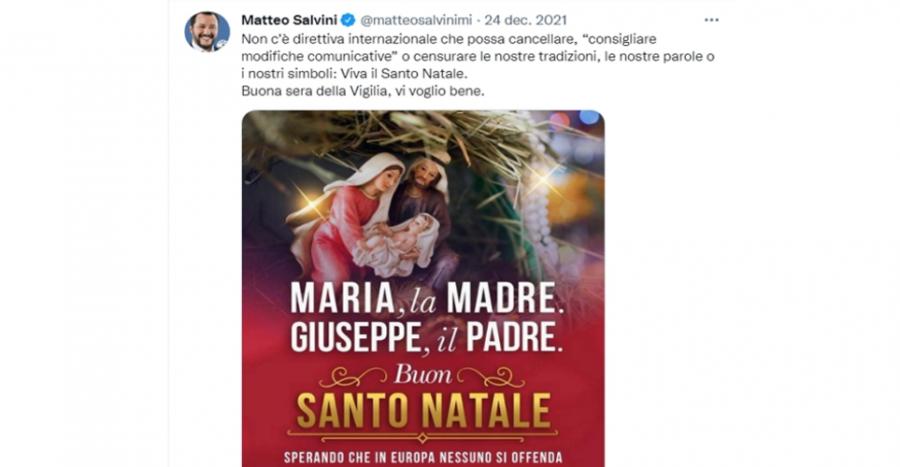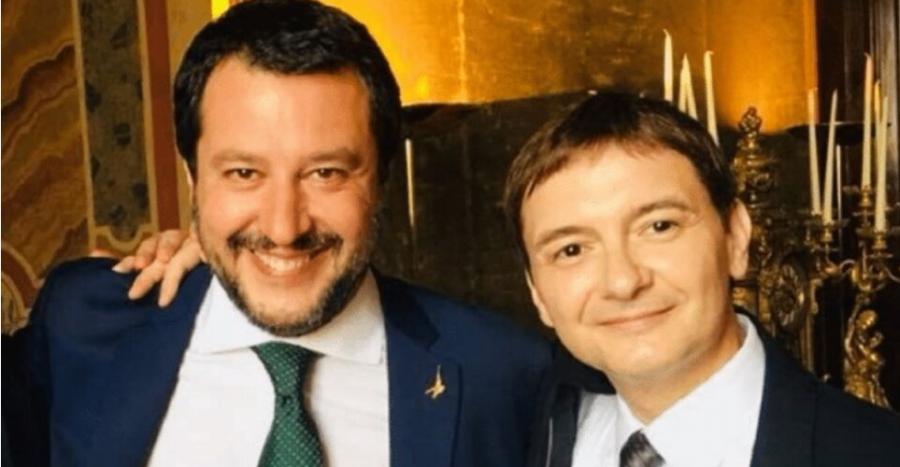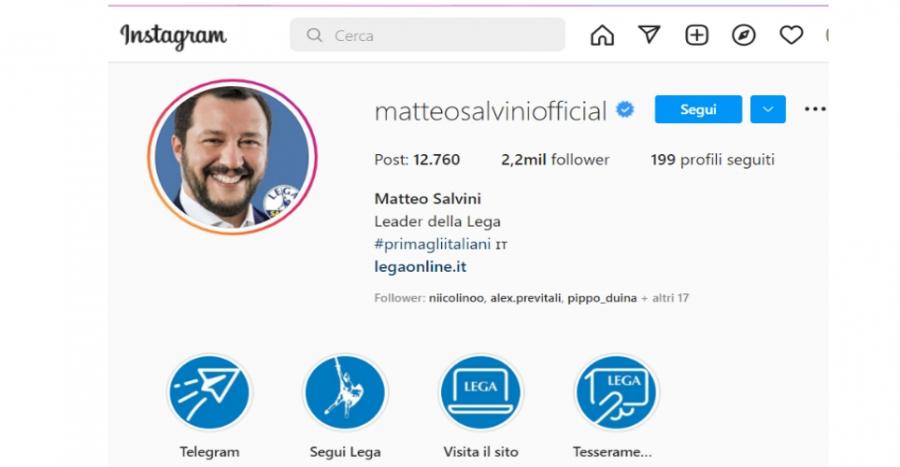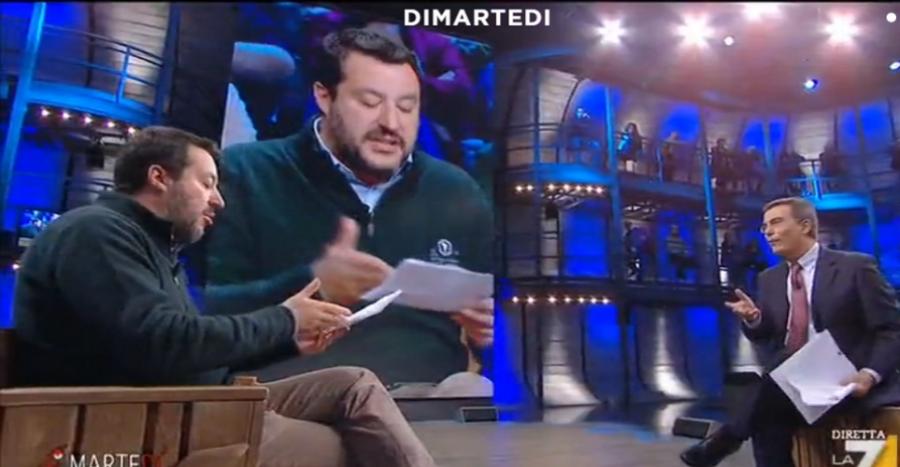
Matteo Salvini: Bridging the Gap Between Traditional and Digital Media
Matteo Salvini is a prominent figure in Italian politics. Part of his influence comes from a successful combination of traditional and digital media advertising. In this article, it is discussed how Salvini manages to stay ahead of the competition.
Salvini and political communication in the 21st Century
In order to understand and analyze the broad and complex world of politics, one surely cannot forget about communication. Esser (2013) goes as far as to state that politics is communication. Political language is characterized not only by the act of speaking (e.g. verbal communication) but also by the politician’s looks, body language, tone of voice, etc. Since the rise of the hybrid media system, which combines traditional media with digital media (Chadwick, Dennis & Smith, 2016), the study of political language has evolved into something even more complicated.
Being experienced in public speaking or answering interviews does not necessarily translate into social media savviness. However, there is an increasing number of politicians who have realized the value of being proficient in both. To stay up to date with modern-day political discourse, for politicians or political commentators alike, it is important to know how to take advantage of the affordances provided by the hybrid media system. The hybrid media system developed after the evolution of digital technologies, which made it so that nowadays the average voter is able to keep up to date with political topics with a simple check of a social network. Traditional and digital media seem to be connected through a loop: what is headlined in the news, may soon become trending online and the other way around.
While traditional media is challenging for politicians to control, with the rise of digital media platforms, politicians are now able to directly manipulate the flow of information to their advantage by writing targeted posts or resharing content which suits their message. They are also able to engage in political discourse with opposing forces more easily: all it needs is a tweet, a comment, or a share. However, despite it being challenging, to fully be able to take advantage of the hybrid media system it is necessary to not only be able to use social media to construct a message, but also to influence legacy media to its advantage (Chadwick, 2016).
Traditional and digital media seem to be connected through a loop: what is headlined in the news, may soon become trending online and the other way around.
Matteo Salvini is fully aware of the impact that media, both digital and legacy, has on eligible voters. Therefore over the years, he invested the time and money to master the use of political communication and consequently to control public debate. Successfully so, Matteo Salvini was in fact featured in Politico’s 28 class of 2019, a list of 28 people, who are predicted to shape and influence Europe in the year ahead. He was considered the most influential person in Italy in the year 2019. How was he able to do that? In this article, we will discuss how Salvini was able to effectively use the hybrid media system to his advantage How he uses the fact that different media platforms require different approaches to communication(Chadwick, 2016). And finally, how, he exercises power in such systems, having grasped how to consistently capture his audience’s attention, surpassing his Italian colleagues in the chaotic world of media today.
Avoiding the gatekeepers
As previously mentioned, part of Matteo Salvini’s success in managing his image through the hybrid media system relies on knowing that different branches of digital media are structurally different from traditional media (Mazzoleni & Bracciale, 2018). Mazzoleni and Bracciale (2018) suggest that these differences stem from three main passages: production, distribution, and usage. Production of content in digital media does not undergo quality checking by professionals like in traditional media. Rather, depending on the platform, there may be little to no moderation of produced content. People like Salvini, who like to speak directly to their followers, use this lack of gatekeeping to their advantage to create content on their terms, rather than subjecting it to broadcasting companies’ code of conduct. The result is (sometimes) bold and antagonizing yet widely spread pieces of media.
Figure 1: Image text: "Mary, the mother. Joseph, the father. Merry Christmas. Hopefully, they aren't offended in Europe."
Distribution of digital media content happens on the basis of virality. Hence, the sharing of content is enabled by popularity among like-minded individuals, rather than by the will of authorized institutions. Finally, the usage of digital media can be translated into communication between people with the same interests. Imagine a particularly successful tweet by Salvini. First, it will be seen by his most avid followers. The interesting phenomenon here is that it does not necessarily have to be Italian citizens who interact with the content in its initial phase. Mazzoleni & Bracciale (2018) mention that whereas mass media consumption is largely reliant on geographical communities, social media platforms define communities by connections between peers with shared interests. Anyone in the world with an internet connection who happens to be interested in Salvini’s work may contribute to the popularity of this content.
As the tweet gains more and more user attention and interaction, it may spread to a wider circle. Perhaps this tweet makes the national trending page. From there on, traditional media creators may pick up his tweet, judging it as ‘viral’ or relevant enough to be mentioned in the national news broadcast. After this, it may very well be that Salvini is invited for an interview, completing the cycle between digital and traditional media. For example, the kind of broadcasts he gets invited to, take a look at the numerous videos on Matteo Salvini’s YouTube channel. This symbiosis of digital and traditional media makes up the hybrid media system, and the politicians who understand how to use it to their advantage are a step ahead of their colleagues.
The powerful foundation of Matteo Salvini’s strategy: Luca Morisi and ‘The Beast’
In the introduction, we emphasized how essential communication is in the political area. Matteo Salvini’s skills in political communication and his consequential achievements regarding the majority of the public opinion are carefully controlled and nurtured by his communication digital team with Luca Morisi as the head of that team (see Figure 2) (Zattin, 2020). Morisi is currently a philosophy of informatics professor at Verona University (Zattin, 2020), however, his skill set is much wider than that. The professor is an expert in databases, web applications, and Intranet/Extranet. Next to that, he is also the founder of a society specialized in web services and IT called Mediatechs and in 2009 Morisi became the owner of another company: the SistemaIntranet (Zattin, 2020). He officially became Salvini’s social media strategist in 2013 (Zattin, 2020)
Figure 2: Matteo Salvini on the left and Luca Morisi on the right
Salvini’s other ace up the sleeve is the Beast, or La Bestia, a personalized informatic system, which is able to suggest which topics are better to focus on for social media posts (Zattin, 2020). Experts defined the Beast as a “listening” tool, which can read conversations, comments, keywords and consequently provide its users with fundamental information about the public’s uptake, for instance how well a topic has been perceived (Zattin, 2020). While the Beast equips Salvini with important resources for his digital media strategy, Luca Morisi can help with all the fronts pertaining to the hybrid media system. On one hand, Morisi guides Salvini on social media by suggesting to distract the public and the media when the government is facing difficult periods; in this way, the politician is able to control the agenda (Zattin, 2020). On the other hand, Morisi makes sure that Matteo Salvini has a consistent presence in traditional media (Zattin, 2020). In sum, Matteo Salvini and Luca Morisi have established a powerful strategy to tackle the hybrid media system today.
How much does Matteo Salvini spend on his social media?
Simply by viewing the numbers on Salvini’s main social networks, it is clear that he makes skillful use of the social platforms and understands the use of digital communication. With 5 million followers on his Facebook, he trumps some of the most influential European politicians such as Macron, who has 4.3 million followers (January 2022), and Merkel, who had 2.5 million followers before her page was deleted.
The following numbers are an approximation since Facebook does not give precise information about the amount paid to the sponsor. The following data is from March 2019 to 31st May 2020. The complete Facebook campaign cost around €255.112 (Il Post, 2019). In the first half of May, there were 24 sponsored posts on Matteo Salvini’s personal Facebook page, each one of which cost between €100 and €5.000. As a rule of thumb, a post with a price tag between €500 and €999 should reach around 200.000 views, while a €5.000 post may even reach 1 million or more views.
Who is financing all of this? Every sponsored post is registered to be paid by “Lega-Salvini premier”, hence directly by the party (Il Post, 2019). The party finances Matteo Salvini’s personal page first and foremost (Il Post, 2019). The numbers on other social platforms further exemplify Salvini's extensive social media presence: Salvini started his Twitter page in 2011 and his page now counts more than 1 million followers (Zattin, 2020). Additionally, he signed up on Instagram in 2014 (sooner than the majority of the European leaders), and up to January 2022 he published more than 12.000 posts and he is followed by 2.2 Million followers (as shown in Figure 3 below).
Figure 3: Matteo Salvini’s Instagram profile on 13/01/2022.
Salvini and the Traditional Media Game
Matteo Salvini undoubtedly demonstrated to have a firm grip on traditional media next to social media. Agcom (Authority for Communications Guarantees) data shows that in January 2019 alone, Salvini appeared in tv programs (more specifically on the Italian channels Rai and La7) more often than all the other politicians in Italy (Zattin, 2020). An example is displayed in Figure 4. The image shows Salvini in one of the many news programs of channel La7, ‘Di Martedi’ (‘On Tuesdays’).
Figure 4: Matteo Salvini during an Interview on the tv program ‘Di Martedì’ airing on the channel La7. 12/11/2019
Politicians often spread personal stories with the purpose of staying in the spotlight and increasing popularity, Mazzoni & Mincigrucci, (2020). This technique has been widely adopted by Matteo Salvini, gaining popularity by exposing his personal traits. In particular, he has been a hot topic in gossip magazines for a long time. A distinct example of this is Salvini’s coverage in gossip magazines between 1st February 2017 and 4th March 2018. (Mazzoni & Mincigrucci, 2020). During this time, there were 67 articles published about Matteo Salvini, which totally or marginally talked about him. In these articles, his political affiliation was totally ignored in favor of his personal life. Between June and July 2017, 6 articles published both in the magazines ‘Chi’ and ‘Oggi’ were dedicated to Matteo and his personal matters. What could have possibly sparked such an interest? The love story between Matteo Salvini and the television showgirl Elisabetta Isoardi during the busiest and most hectic period in the Italian scene: The Sanremo Festival (Mazzoni & Mincigrucci, 2020). The politician assured himself of two articles during the middle of the election campaign: Both covers displayed Salvini and Isoardi among the public at the Sanremo Festival, granting him an advantage over the other political competitors (Mazzoni & Mincigrucci, 2020).
Mainstream media broadcasts may cause a surge of discussion in social media spheres and the other way around
Salvini connects digital and traditional media
The hybrid media system of today makes it so that there is a connected cycle between social media and mainstream news networks. Mainstream media broadcasts may cause a surge of discussion in social media spheres and the other way around. An example of real-time interaction between the two is the phenomenon of dual screening: It has been reported that Twitter activity increases during live broadcasts. Salvini makes use of this fact by providing links to live streams where he is present. Figure 5: Salvini announces a live stream via Twitter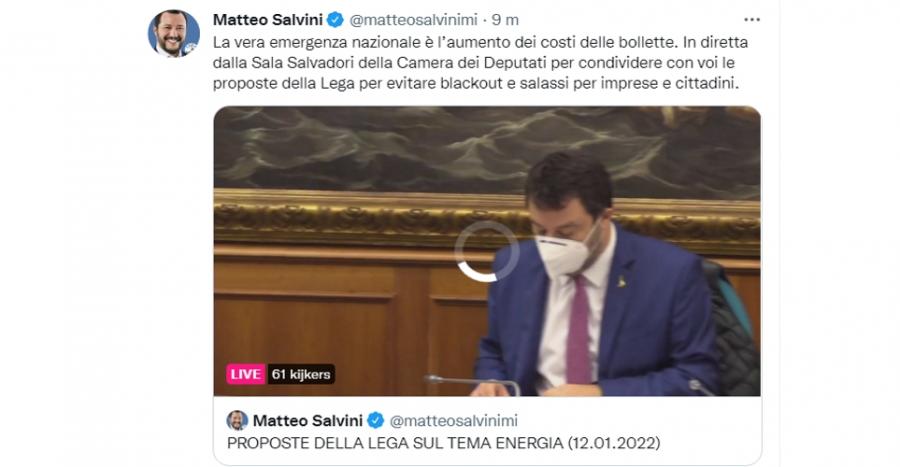
By announcing the time that he is on air, Salvini’s followers are invited to contribute to the discussion of the topic at hand. The example of Figure 5 shows a live discussion on the topic of ‘energy’. Using the relatively fast-paced nature of Twitter, Salvini draws attention to where he wants it. If a traditional media company notices that ‘energy’ has become trending along with Salvini's name, they may invite him to a broadcast on this topic, only further attributing to his popularity. Of course, there are multiple reasons to invite Salvini to television, he is a popular politician after all. Though the fact that he is so vocal and visible on social media is most assuredly makes him a desirable guest as well. People want to see and hear Salvini, and he has the followers to prove it.
In conclusion, the hybrid media system can be very effective for anyone who wishes to broadcast their values to the masses. There is, however, an element of unpredictability to this loop. While scriptwriters for news reports can say with great certainty that their message will be broadcasted, the success of a social media post is not always guaranteed. The underlying algorithms that push posts to the intended audience are ever-changing and more often than not a well-kept company secret. This uncertainty of success is one of the reasons why social media presence alone is not enough to reach your target audience as a politician. The inverse can be said as well, as traditional media is often labeled ‘boomer media’, and passes by many young eligible voters. Salvini arguably has been able to combine the advantages of both worlds, maintaining a substantial social media audience and a mainstream media image at the same time.
References
Chadwick, A., Dennis, J., & Smith, A. P. (2016). Politics in the Age of Hybrid Media: Power, Systems, and Media Logics. In Bruns, A., Enli, G., Skogerbø, E., Larsson, A. O., & Christensen, C. (eds). (2016) The Routledge Companion to Social Media and Politics.
Esser, F. (2013). Mediatization as a challenge: Media logic versus political logic. in H. Kriesi et al. (eds.) Democracy in the age of globalization and mediatization, Basingstoke: Palgrave Macmillan, pp. 155–176.
Il Post. (2019, May 13). Come la Lega spende i soldi sui social.
Mazzoleni, G., & Bracciale, R. (2018). Socially mediated populism: the communicative strategies of political leaders on Facebook. Palgrave Communications, 4(1).
Mazzoni, M., & Mincigrucci, R. (2020). The representation of Matteo Salvini in gossip magazines: the Ordinary Super Leader. Contemporary Italian Politics, 13(1), 49–63.
Zattin, F. (2020). Comunicazione politica, social network e populismo: due strategie, un partito. Osservatorio Democrazia a Nord Est - DANE, 1–32.
